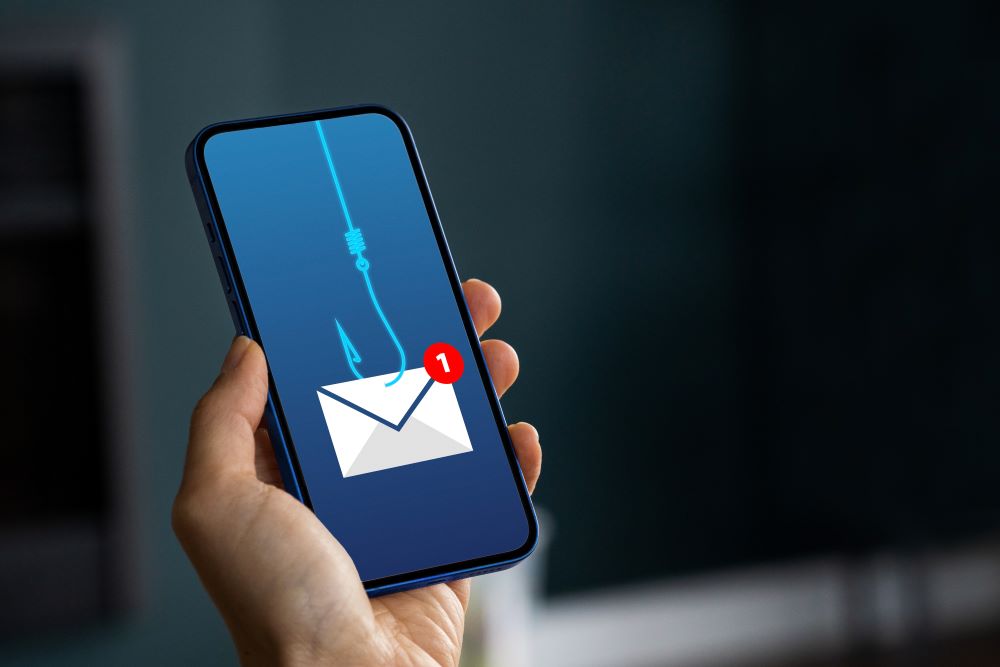
Now is the time to learn to protect yourself against a growing digital threat: text phishing. In a world where digital communication is everywhere, SMS phishing, or “smishing”, has become an alarming and rapidly growing form of cybercrime.
Groupe SL, your cybersecurity partner to strengthening IT security , provides essential advice on how to identify and avoid smishing traps.
What is smishing?
Phishing is nothing new, however many people may still need to ask: “What is smishing“?
Smishing relies on fraudulent text messages to steal confidential information. Cybercriminals carefully craft personalized messages to trick their victims into giving up personal or financial data. The messages may claim to be from a well-known company, government or even an acquaintance, to allay suspicion.
How does smishing work?
Text phishing plays on urgency and fear. It involves sending an SMS message urging victims to tap on a link.
This type of fraudulent text message may simulate a bank fraud alert or promise an unexpected refund, prompting victims to click on a link or provide personal information like credit card details. Smishing criminals use social engineering to include customized information in their messages, exploiting people’s trust and willingness to help.
Smishing threats are a growing concern as more and more people use smartphones, as they undermine the cybersecurity of your data.
What is social engineering?
Social engineering refers to the methods used by cybercriminals to manipulate people into revealing confidential information. It exploits people’s natural tendency to trust and help others, enabling criminals to gain access to valuable personal and business data which are usually used to perpetrate other acts of cybercrime.
Smishing tactics
Phishing text messages rely on a variety of methods to trick their victims. This section explores these tactics, from deceptive links to false security alerts. Each strategy aims to exploit the trust and quick response of mobile phone users. Being aware of these methods is crucial to protecting yourself and your company.
Deceptive links
With this approach, the scammer poses as a legitimate entity and attaches a link to the message that imitates the address of an official website. The aim is to entice the victim to tap on the link to perform certain actions, such as updating a device, updating personal information, confirming a delivery or entering a contest.
False incentives
Here, the fraudster sends a text message inviting the victim to call a specific phone number, often under the guise of an official organization. The caller will claim that the victim needs to take immediate action to avoid trouble. If the victim does as asked and makes the call, they are usually answered by someone who expertly reassures them and gains their trust, ultimately convincing them to share the information they want to steal.
Malware attacks
A smishing attack can also be in the form of a message that contains a link to a malicious file. When the victim taps on the link, malware (often a Trojan horse) is installed on their device. This type of software is designed to record keystrokes, which enables fraudsters to steal passwords, banking details and other sensitive information.
Spear phishing
This method requires extensive research by the cybercriminal, who gathers information about his victim via platforms such as Facebook or LinkedIn. Armed with this data, the scammer launches a personalized and specific attack, making the phishing message credible and difficult to detect, thus prompting the victim to respond without suspicion.
Warning signs of smishing
There are several telltale signs of a phishing text message used by fraudsters:
- Messages that create a sense of urgency or fear
- Requests to update or confirm personal information
- Links to suspicious websites
- Messages from unknown or strange phone numbers
How to protect your company from smishing
Effectively countering smishing threats in the workplace demands a comprehensive, proactive approach. Here are the key steps to put in place:
- Training and simulation: Organize frequent training and phishing simulations to teach your employees how to identify suspicious messages. With practise, employees will find it easier to detect phishing attempts and avoid sharing sensitive information with unverified sources.
- Security practices: Encourage employees never to interact with messages from unknown senders. Delete mystery messages immediately and block suspicious numbers to prevent future infiltration.
- Awareness campaigns: Organize regular campaigns to inform employees about social engineering tactics and the methods cybercriminals rely on, so they can get better at identifying potential threats.
- Awareness assessment: Ask your organization’s security managers to periodically assess employees’ awareness of and responsiveness to phishing threats, to be sure they remain aware and have up-to-date knowledge of smishing threats.
- Mobile device protection: Protect your employees’ cell phones with relevant software.
Groupe SL: your IT security services provider in Quebec
Text messaging is more than just a communication tool; it can pose a serious it risk to your company’s IT security. In the face of risks like suspicious messages, theft of personal or financial data, and other SMS fraud, vigilance is essential. And with the rise in use of smartphones, cybersecurity challenges related to smishing will only increase.
When you choose Groupe SL as your managed IT services and IT security provider in Quebec, you’re choosing a reliable ally to protect your data and systems.
Contact Groupe SL to benefit from custom solutions for total peace of mind.





